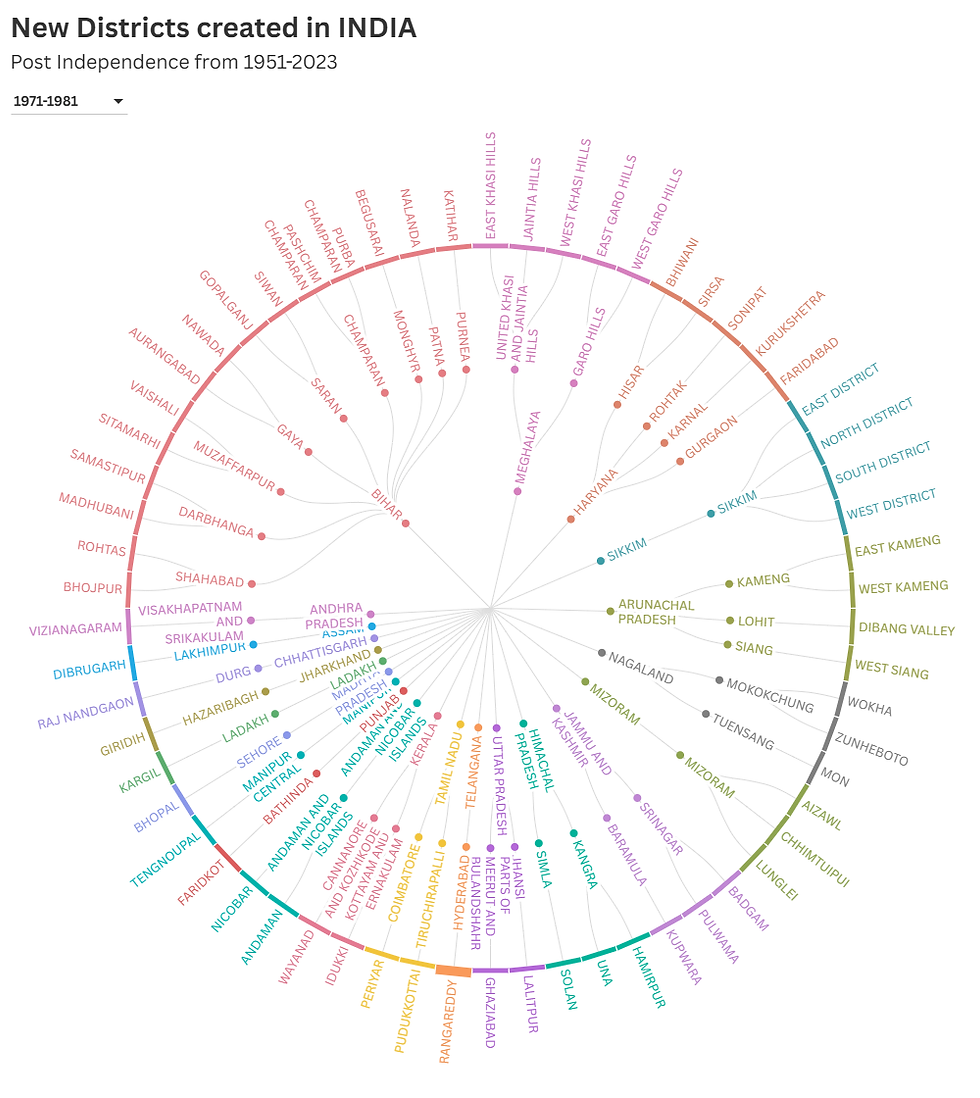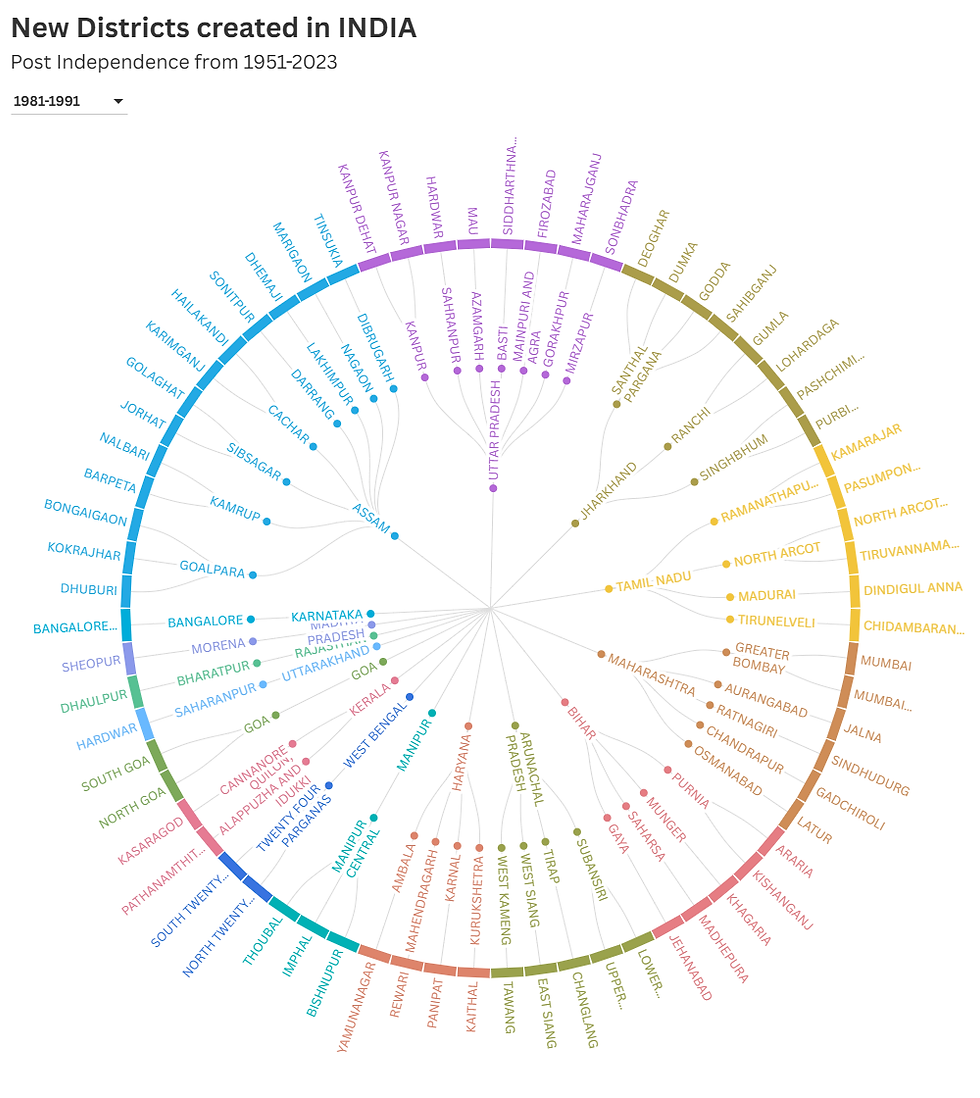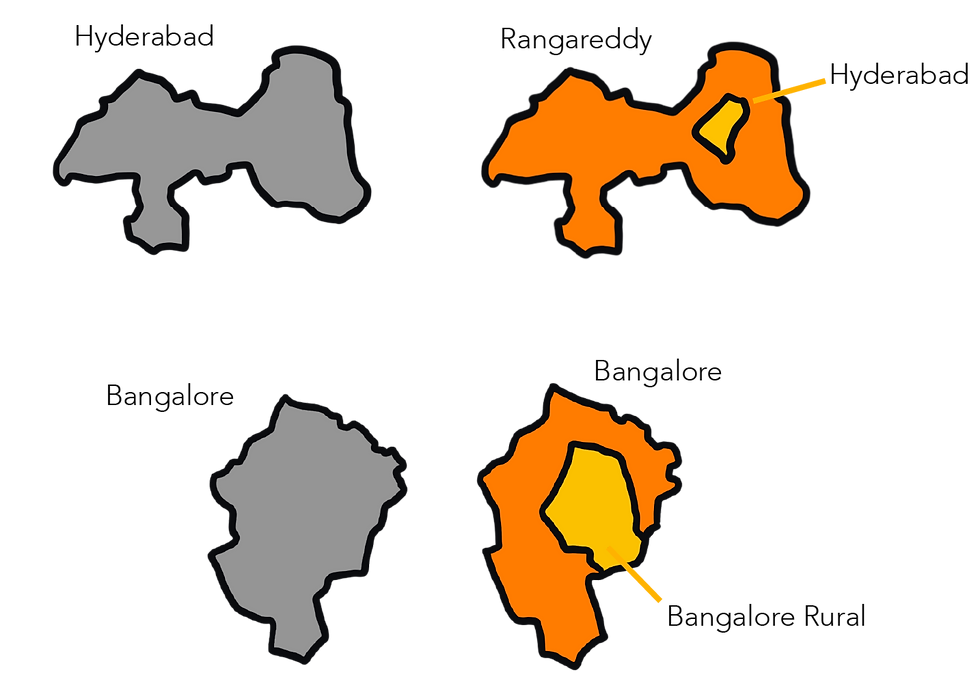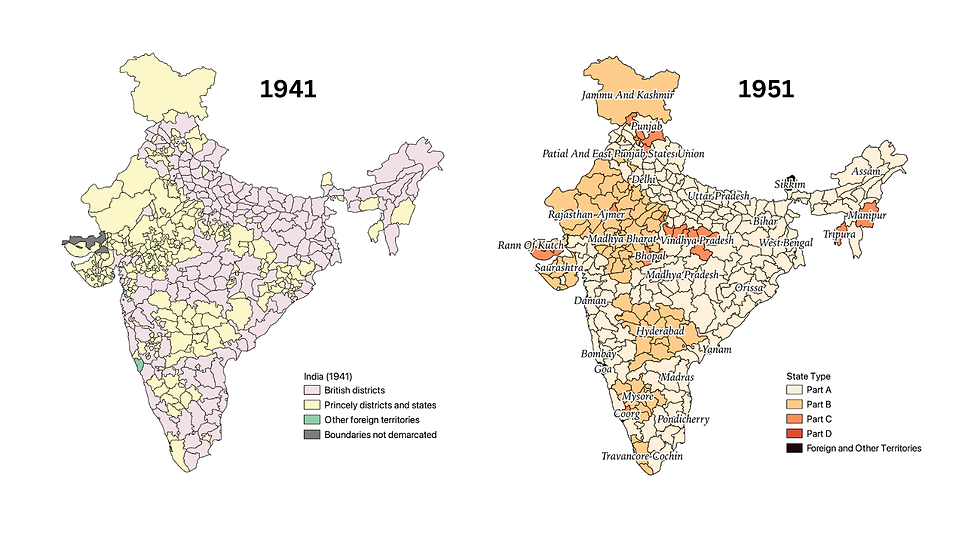5 | District changes post reorganization of Punjab and North Eastern States : 1971 to 1991
- indiastatestories
- Aug 1
- 4 min read
Updated: Aug 20
District changes between 1971 to 1981
The creation of new districts during the 1971-1981 period reflects India's continued efforts to improve administrative efficiency, address regional aspirations, and accommodate growing populations and diverse needs.
The Census publication ‘A Historical Perspective of Evolution of Districts and States in India. Registrar General of India’ (Singh et al, 2004), records the comprehensive changes in the administrative reorganization between 1971-91. Total districts increased from 357 in 1971 to 412 in 1981, while there was a further increase of 54 districts in 1991.
The changes between 1971-1981 are summarized as follows:
Jammu & Kashmir: Four new districts formed by redrawing/bifurcating: Pulwama, Badgam, Kupwara, and Kargil. Total 14 districts.
Himachal Pradesh: Three new districts: Hamirpur, Una, and Solan. Mahasu district (excluding Arki and Solan tahsils) renamed Simla. Total 12 districts.
Punjab State: New Faridkot district created from Bhatinda and Firozpur. Ropar district was renamed Rupnagar. Total 12 districts.
Haryana State: Gained five new districts: Sonipat, Bhiwani, Kurukshetra, Faridabad, and Sirsa. Total 12 districts.
Uttar Pradesh: Two new districts: Lalitpur (from Jhansi) and Ghaziabad (from Meerut). Total 56 districts.
Madhya Pradesh: Two new districts: Bhopal (from Sehore) and Raj Nandgaon (from Durg). Total 45 districts.
Bihar: Largest number of districts (14) created: Nalanda, Nawada, Aurangabad, Rohtas, Siwan, Gopalganj, Begusarai, Giridih, Katihar, Pashchim Champaran, Sitamarhi, Vaishali, Samastipur, and Madhubani. Total 31 districts.
Assam State: New Dibrugarh district created by bifurcating Lakhimpur. Total 10 districts. Mikir Hills renamed Karbi Anglong.
Meghalaya State: Three new districts: East Garo Hills, West Garo Hills (from Garo Hills), and East Khasi Hills, West Khasi Hills, Jaintia Hills (from United Khasi & Jaintia Hills). Total five districts.
Sikkim: Declared a full-fledged state in 1975 (36th Constitutional Amendment). Uni-district state divided into four districts: North, West, South, and East Districts.
Nagaland State: Four new districts: Phek, Zunheboto, Wokha, and Mon. Total seven districts.
Manipur: New Tengnoupal district formed by bifurcating Manipur Central district. Total six districts.
Arunachal Pradesh UT: Four new districts created: West Kameng, East Kameng (from Kameng), West Siang, East Siang (from Siang), Lower Subansiri, Upper Subansiri (from Subansiri), and Dibang Valley (from Lohit). Total nine districts.
Mizoram UT: Uni-district territory divided into three districts: Aizawl, Lunglei, and Chhimtuipui.
Andaman & Nicobar Islands UT: Bifurcated into two districts: Andaman and Nicobar.
Kerala State: Two new districts: Idukki and Wayanad. Total 12 districts.
Tamil Nadu: Two new districts: Periyar and Pudukkottai. Total 16 districts.
Karnataka: Mysore state renamed Karnataka (Mysore State Alteration of Name Act, 1973).
Andhra Pradesh: Two new districts. Vizianagaram was created from Visakhapatnam and Srikakulam. Rangareddi formed from excluded area of Hyderabad. Ongole district was renamed Prakasam. Total 23 districts.
Unaffected States/UTs: Rajasthan, Orissa, West Bengal, Tripura, Karnataka, Gujarat, and Maharashtra, and UTs Chandigarh, Dadra & Nagar Haveli, Delhi, Goa, Daman & Diu, Lakshadweep, and Pondicherry were unaffected by district level administrative changes.

District changes between 1981-1991
The decade between 1981 and 1991 saw the creation of numerous districts across India. No of districts increased from 412 to 466.
States and UTs Status Changes:
Goa, Daman & Diu UT split: Goa declared a state, while Daman & Diu remained a Union territory.
Arunachal Pradesh and Mizoram got statehood status.
Total states increased to 25, Union territories decreased to 7, total states and UTs became 32.
New Districts: 54 new districts created across the country.
Assam: 13 new districts.
Bihar: 11 new districts.
Uttar Pradesh: 7 new districts.
Tamil Nadu: 5 new districts.
Haryana: 4 new districts.
Maharashtra: 4 new districts.
Arunachal Pradesh: Two old districts, Tirap and West Kameng, were divided into Changlang and Tawang respectively, alongside the creation of Lower Subansiri, Upper Subansiri, and East Siang, reflecting efforts to improve governance in geographically challenging and tribal-dominated regions through the bifurcation of large units like Subansiri, Tirap, Siang, and West Kameng.
Assam: Boundaries of 10 old districts were redrawn to form 13 new districts—Sonitpur, Marigaon, Dhemaji, Tinsukia, Kokrajhar, Dhuburi, Bongaigaon, Barpeta, Nalbari, Golaghat, Jorhat, Hailakandi, and Karimganj—resulting in a total of 23 districts, with major reorganizations between 1983 and 1989 to address governance and representation needs.
Bihar: Eleven new districts were created—Pashchimi Singhbhum, Purbi Singhbhum (from Singhbhum), Lohardaga, Gumla (from Ranchi), Jehanabad (from Gaya), Kishanganj, Araria (from Purnia), Madhepura (from Saharsa), Khagaria (from Munger)—and Santhal Pargana was reorganized into Sahibganj, Godda, and Deoghar, abolishing the old Santhal Pargana district; these changes addressed tribal aspirations and governance needs, taking the total to 42 districts.
Goa: In 1987, after attaining statehood, Goa was divided into North Goa and South Goa to improve regional governance.
Haryana: Four new districts—Yamunanagar (from Ambala), Panipat (from Karnal), Kaithal (from Kurukshetra), and Rewari (from Mahendragarh)—were created in 1989 to meet growing administrative demands in an agriculturally rich and rapidly developing state, bringing the total to 16 districts.
Karnataka: Bangalore district was bifurcated into Bangalore and Bangalore Rural, increasing the total by one district.
Kerala: Kasaragod (from Cannanore) and Pathanamthitta (from Quilon) were created between 1982 and 1984 to address unique cultural and administrative needs, bringing the total to 14 districts.
Maharashtra: Four new districts—Sindhudurg (from Ratnagiri), Jalna (from Aurangabad & Parbhani), Latur (from Osmanabad), and Gadchiroli (from Chandrapur)—were created between 1981 and 1990 to improve administration in rural, tribal, and urbanizing regions, alongside the reorganization of Mumbai and Mumbai Suburban.
Manipur: Manipur Central district was divided into Manipur Central (retained), Thoubal, and Bishnupur in 1983 to better serve distinct ethnic and cultural groups, increasing the total to eight districts.
Rajasthan: Dhaulpur district was created from Bharatpur, increasing the total by one.
Tamil Nadu: Five new districts—Tiruvannamalai Sambuvarayar (from North Arcot), Dindigul Anna (from Madurai), Chidambaranar (from Tirunelveli), Kamarajar, and Pasumpon Muthuramalinga Thevar (from Ramanathapuram)—were created between 1985 and 1989, taking the total to 21 districts.
Uttar Pradesh: Seven new districts—Hardwar, Firozabad, Siddharthnagar, Maharajganj, Mau, Sonbhadra and the bifurcation of Kanpur into Kanpur Dehat and Kanpur Nagar increased the total to 63 districts, with reorganizations between 1981 and 1989 to address urban and semi-urban governance needs.
West Bengal: The large Twenty Four Parganas district was bifurcated in 1981 into North Twenty Four Parganas and South Twenty Four Parganas to manage population growth, increasing the total by one.

Reference
Government of India. (2011). Indian Administrative Atlas 1872-2011: Census of India 2011. Registrar General of India and Census Commissioner.
Singh, R. P., Banthia, J. K., & Commissioner I. O. of R.G. & C. (2004). India Administrative Atlas, 1872-2001: A Historical Perspective Of Evolution Of Districts And States In India. Registrar General of India.




Comments